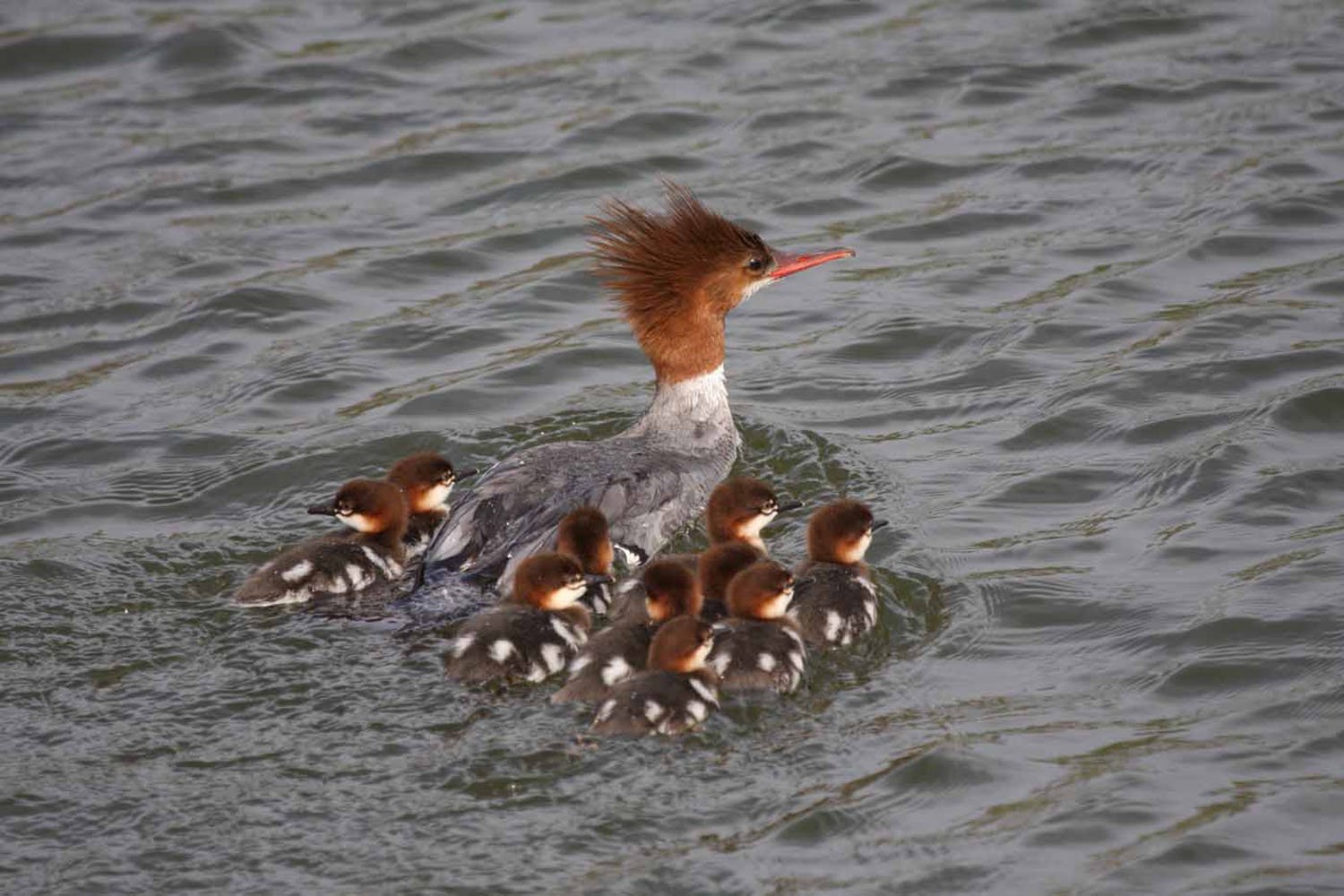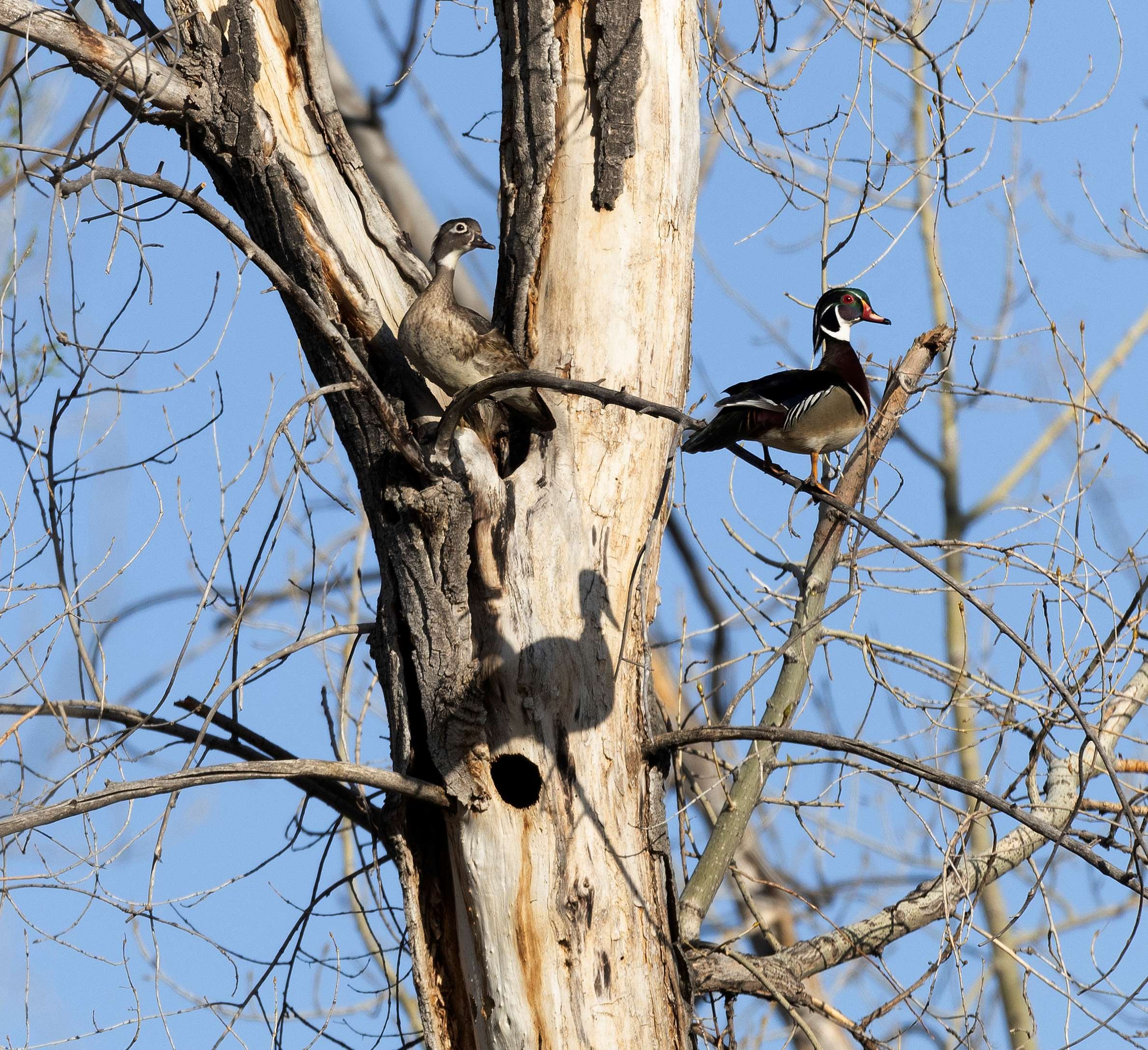February Nature Almanac: Cavity-Nesting Ducks Take to Front Range Woodlands
By Stephen Jones, with Ruth Carol Cushman and Scott Severs
February 2024
On a frigid morning in mid-January, Boulder's John Weller watched in awe as 50 Hooded Mergansers performed their wild courtship dances on the surface of an Arvada gravel pond. As the male hoodies threw their heads back and cackled while circling potential mates, two dozen colorful Wood Ducks gazed on placidly.
Hooded Merganser males dance and cackle around a lone female on a gravel pond in Arvada. Photo by Stephen Jones.
"That's by far the most dancing Hooded Mergansers I've ever seen in one place," said Weller, an international conservationist and wildlife photographer. "And to see all those gorgeous Wood Ducks at the same time was a special treat."
A few days later, John drove out to Barr Lake, east of Brighton, where tens of thousands of Common Mergansers (colloquially known as "Razorbills" for their serrated bills, used for snaring fish) floated on the surface and lifted skyward in swirling waves.
Common Mergansers fly swiftly over prairie streams throughout the winter months before laying their eggs in large tree cavities, often in rotting cottonwoods. Photo by Joel Such.
"When I first arrived at the lake," John said, "all I could see was innumerable black dots toward the far shore. But when I put my spotting scope on them, they appeared as a foamy mass of waterfowl stretching all the way across the lake."
Fifty years ago, some of us would have driven miles to see courting mergansers, and Wood Ducks were considered uncommon in Boulder County. What has changed?
What these three species have in common is that they nest in tree cavities, including holes previously excavated by woodpeckers. Tree cavity-nesters comprise nearly one-third of all duck species in North America, but these woodland beauties were once considered rarities at the base of the Front Range foothills. Until the latter half of the 20th century, there were few trees to nest in and almost no ponds to float on.
When University of Colorado Museum curator Junius Henderson published his Birds of Boulder County monograph in 1909, he referred to just two bodies of water on the plains of Boulder County: Sombrero Marsh and Gaynor Lake. Both are "prairie playas," shallow depressions that typically go dry during the late summer months.
Now there are literally hundreds of gravel ponds and reservoirs in eastern Boulder County. These ponds are especially attractive to the mergansers, who subsist largely on crayfish that dwell on the gravelly bottoms. During the past 40 years, Hooded and Common Mergansers began nesting at a dozen locations in Boulder, Larimer, and Jefferson County.
A Wood Duck pair peers out of a nest cavity in eastern Boulder County. The number of Wood Duck nests observed annually in eastern Colorado has more than doubled since 1990. Photo by John Weller.
As for trees, photos from the early 1900s show very few on the plains. In 1846, adventurer Francis Parkman wrote of riding on horseback several miles up Laramie Creek above Fort Laramie before finding welcome shade under a lone cottonwood. Now that stretch of stream is lined with cottonwoods, as is every prairie stream in Boulder County. The elimination of prairie fires and roaming bison, along with the creation of artificial ponds, facilitated this spread.
Along Boulder Creek, we now expect to see nesting Wood Ducks every spring. We've observed as many as three pairs nesting at Sawhill Ponds, alone, and a couple of celebrated males spend each winter paddling within a stone's throw of the Boulder Public Library.
This handsome Wood Duck is among several males who have wintered in Boulder Creek below the Boulder Public Library. Photo by Stephen Jones.
While the spread of deciduous trees along our creeks has proved a bounty for cavity-nesting ducks and birdwatchers, it poses an existential threat to many of our native grassland species. Burgeoning riparian woodlands attract legions of urban-adapted predators, including Red-tailed Hawks, Great Horned Owls, Blue Jays, American Crows, Common Grackles, raccoons, and fox squirrels.
As the trees spread into adjacent grasslands, so do the predators, taking a toll on nesting Burrowing Owls, Grasshopper Sparrows, and Lark Buntings. Burrowing Owls, considered locally common in Junius Henderson's day, are now listed as "imperiled" in the Environmental Resources Element of the Boulder County Comprehensive Plan. Lark Buntings, once considered the most abundant bird on the plains of Boulder County, haven't been reported nesting for several years.
Wood Ducks often mate for life, but during January and February, when the birds gather in small flocks, there's plenty of potential for pair swapping. Photo by Stephen Jones.
The loss of these unique native species is heartbreaking for those of us who treasure natural beauty and biological diversity. The sudden appearance of all the cavity-nesting ducks seems like a minor miracle at first but becomes small consolation when we realize how much we have transformed our prairie landscape.
Other February Events
Early Easter Daisies bloom on their shale slopes in foothills canyons.
Bald Eagles lay eggs in giant nests placed in Plains Cottonwoods, while Golden Eagles nest on cliffs in the foothills and mountains.
Mountain Bluebirds return from the south and begin to stake out tree cavities in foothills and mountains conifers where females will begin laying eggs in April.
Coyotes and red foxes mate and enlarge their dens, often located under large boulders or within earthen mounds.





